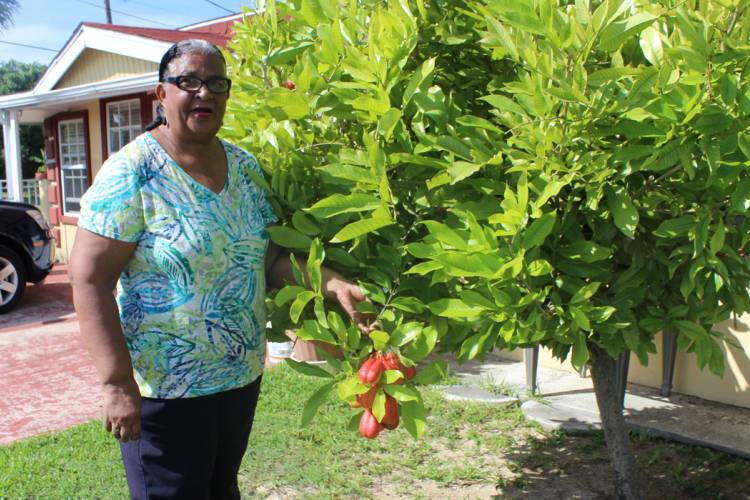The “Fruits” of 7 Cayman Trees

Learning about other cultures is a fascinating journey, and Cayman culture is worth the exploration. Take some time to see if you can find the following trees of cultural significance to the Cayman Islands and their products on your next trip to the island. (Make a scavenger hunt out of it!) Some produce literal fruits that are happily consumed, while others have been used to create essential products for the island.
Ironwood Tree
There are common trees around the world called Ironwood, but the tree referred to as the Ironwood tree in Cayman is endemic to the Cayman Islands, important to the culture and unfortunately endangered. Used to build the framework for early homes (like Dovovan’s grandfather’s home), the wood of the tree is heavy, water resistant and termite proof. Ironwood was first used in Wattle and Daub construction and then throughout the years in various construction.
Where they grow: Dense forests such as the Ironwood Forest, Forest at Crystal Caves, and the Mastic Reserve.
Silver Thatch Palm
Also used in the Wattle & Daub buildings (for roofs) of early settlers, the Silver Thatch Palm was used in a multitude of additional products, many with economical value, and is vastly significant to the history of the Cayman Islands. The Silver Thatch was weaved into ropes, hats, brooms, baskets, fans and much more. Because of its strength, the thatched rope was in high demand from neighbors in Cuba and Jamaica and thereby created a roping industry that helped support the island. Because of it’s impact, it’s no surprise the Silver Thatch Palm is the national tree of the islands.
Where they grow: All over the island and especially present on the East End
Where you can find products: Try the Cayman Craft Market at The Waterfront in Georgetown or one of the local Farmers Markets for thatched products.

Breadfruit Tree
The Breadfruit Tree has long been providing sustenance to those living on island. According to A Cayman Childhood Remembered by Jackie Bodden, a Breadfruit is “a large, round, usually seedless fruit with a starchy pulp. When cooked it tastes similar to an Irish potato.” The breadfruit is still a popular fruit today among Caymanians—in fact our property manager gifted me a breadfruit during my last trip to Cayman. She said that Caymanians love to eat breadfruit with fish, with gravy, with fried chicken, with anything!
Where they grow: All over the island, and grown in the yards of many residents.
Where you can find breadfruit: When in season you can buy breadfruit in local grocery stores, and some local restaurants such Vivine’s Kitchen in the East End will serve breadfruit dishes.

Ackee Tree
Speaking of what to eat breadfruit with, ackee and cod is another dish that Caymanians love to pair with the fruit. The Ackee tree bears a red fruit that can be toxic before it is ripe or when it is too old, so it’s important to get the fruit from a store or a local that knows when it is ready to eat. When ripe it’s full of many healthy nutrients. The meat of the ackee fruit looks similar to scrambled eggs, and has a slightly sweet and slightly bitter taste that is the perfect compliment to the codfish. The ackee and cod dish is especially popular for breakfast.
Where they grow: Grown in the yards of many residents, these trees became prevalent when Jamaicans migrated to Cayman in the 60’s according to Roger Ebanks.
Where you can find ackee: Eat like a local and grab ackee and cod for breakfast at Full of Beans Cafe or Champion House II, both in Georgetown.

Seagrape & Popnut Trees
Original homesteads in Grand Cayman were often shaded by seagrape and popnut trees. Popnut trees were also used in the making of Cayman catboats (along with mahogany and fiddlewood trees). Both trees tend to grow near the shore. The seagrape tree is known for its green leaves with red veining and the edible fruit that it bears (ask a local how to tell when seagrapes are ripe for eating). The popnut tree has yellow flowers that last only a day and turn maroon by the end of the day. It also has a brown leathery fruit bulb that resembles a nut.
Where they grow: Head to the sea and you’re sure to find one or both of these trees. You can enjoy the shade of seagrape and popnut trees at Smith’s Cove and many other beaches on Grand Cayman, including our very own beach here at CCC!

Mango Trees
Come June and July you'll hear lots of excitement over mangoes in the Cayman Islands. That's because during these two months mangoes become ripe for the picking, and Caymanians love their mangoes. There are many varieties that grow here including the East Indian, Carrie, Julie and local long and round mangoes, to name a few. Fresh mangoes are divine. Locals enjoy them on their own, in dishes and also make delicious jams with them.
Where they grow: Many locals enjoy having a mango tree in their yard. These trees are also grown on local farms.
Where you can find them: When in season the best place to get a mango is at a Farmer's Market or a road side fruit stand. We often spot Willie's Farm stand where Frank Sound Road meets Bodden Town Road, and there's another stand usually near Spotts Cruise Terminal. Of course there are other popups around the island, too.

